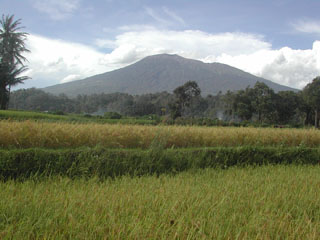Report on Marapi (Indonesia) — 19 March-25 March 2025
Smithsonian Institution / US Geological Survey
Weekly Volcanic Activity Report, 19 March-25 March 2025
Managing Editor: Sally Sennert.
Please cite this report as:
Global Volcanism Program, 2025. Report on Marapi (Indonesia) (Sennert, S, ed.). Weekly Volcanic Activity Report, 19 March-25 March 2025. Smithsonian Institution and US Geological Survey.
Marapi
Indonesia
0.38°S, 100.474°E; summit elev. 2885 m
All times are local (unless otherwise noted)
The Pusat Vulkanologi dan Mitigasi Bencana Geologi (PVMBG) reported that eruptive activity at Marapi (on Sumatra) continued during 19-25 March. Daily white plumes generally rose as high as 250 m above the summit and drifted in multiple directions. At 0229 on 20 March a dense gray ash plume rose 1 km above the summit and drifted S. An eruptive event was recorded at 0842 on 22 March but not visually observed due to weather conditions. According to a news report the event produced a loud bang heard in several areas including Padang Panjang City (11 km SW), Koto Baru (15 km NNW), Sungai Pua Village (7 km NW), and Bukittinggi City (13 km NW). One resident in Bukittinggi City noted that loud bangs had been heard quite often over the previous few months. The Alert Level remained at 2 (on a scale of 1-4) and the public was warned to stay 3 km away from the active crater.
Geological Summary. Gunung Marapi, not to be confused with the better-known Merapi volcano on Java, is Sumatra's most active volcano. This massive complex stratovolcano rises 2,000 m above the Bukittinggi Plain in the Padang Highlands. A broad summit contains multiple partially overlapping summit craters constructed within the small 1.4-km-wide Bancah caldera. The summit craters are located along an ENE-WSW line, with volcanism migrating to the west. More than 50 eruptions, typically consisting of small-to-moderate explosive activity, have been recorded since the end of the 18th century; no lava flows outside the summit craters have been reported in historical time.
Sources: Pusat Vulkanologi dan Mitigasi Bencana Geologi (PVMBG, also known as CVGHM), Antara News

